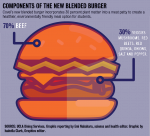Students can now enjoy a blended burger made up of plant matter and meat as a healthier and more environmentally friendly choice at Covel Commons Residential Restaurant.
The Covel dining hall introduced the blended burger patty for Covel’s signature UCLA burger Monday. The burger patty is made up of 70 percent ground beef and 30 percent plant matter, including red beets, red quinoa, onion and mushroom.
Al Ferrone, senior director of UCLA Dining Services, said he wanted to create a healthier burger without sacrificing flavor. Ferron added he got the idea for a blended patty from meatball recipes, which often include vegetables.
“Who hasn’t made meatballs before?” he said. “People don’t really care about what vegetables are with the meat, as long as it tastes good.”
Dolores Hernandez, a nutrition education coordinator for UCLA Dining Services, said she thinks the blended patty will promote healthier diets for students who do not want to completely give up meat.
“We don’t want to take things away from students, but we always want there to be a healthier option,” she said.
For example, the blended patty recipe reduces the amount of total fat from 25 to 12 grams while still being high in protein, Hernandez said.
Jennifer Jay, a professor of environmental engineering, said the blended burger also has a reduced carbon footprint compared to all-meat patties. Jay said her research has shown that the amount of carbon dioxide produced by a serving of a 60 percent beef and 40 percent plant-based burger patty produces less carbon dioxide produced by a 100 percent beef burger.
Joey Martin, the executive chef at UCLA Dining Services, said that while the blended burger is 70 percent beef and 30 percent plant-based, he plans to alter the blended burger recipe to be 60 percent beef and 40 percent plant-based.
Jay added beef products have disproportionately higher carbon dioxide emissions compared to plant-based products, because more resources, such as water, land and feed, are needed for cows.
“When a student chooses to eat the blended burger instead of a 100 percent beef burger, the difference in carbon footprint is substantial,” Jay said. “A majority of the carbon footprint comes from beef consumption.”
Isabel Ketner, a first-year electrical engineering student, said she thinks the blended patty has a slightly different texture from a 100 percent beef patty.
“It’s a little dry, but it still tastes like a normal burger,” she said. “I like burgers, so I would have it again.”
Jasmine Wong, a fourth-year gender studies student, said she likes the blended patty because it is less greasy than a regular patty and is more environmentally friendly.
“I wouldn’t know there were vegetables in the burger unless someone told me,” she said. “I know the dining halls use a lot of meat, so I think this (blended burger) could make a big difference (environmentally).”
Ferrone said he plans to expand the blended burger recipe to other dining halls in the future.
“We may add an Asian flair to the blended burger recipe for Feast, and something different for De Neve as well,” he said.

Why not just have a plant-based burger and get rid of meat? SO much healthier for the environment and people. Ground beef is a big cause of global warming and is a cancer-inducer. Know the facts.
I demand that my burger be cruelty-enhanced.
They aren’t getting rid of the 100% beef burger, right?